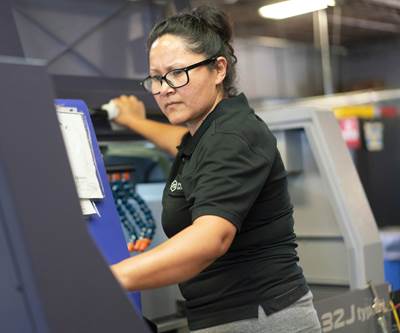Why Is It Okay to Fire a Customer?
Standing up for your employees shows that your company values are more than just words on a wall.
Share





Aneesa Muthana with Pioneer Service Controller Alma Muka (left) and VP of Sales and Marketing Beth Swanson (middle).
We work overtime to meet the demands of our customers, and rightfully so. Our success depends on our reputation and repeat business. So much so that going the extra mile in communication and delivery has effectively become the new baseline for good customer service for successful businesses.
This is all well and good. I’m proud of our industry’s efforts to elevate the standard through innovation and technology, and it’s working. Even so, elevated standards mean bigger risks for customers and suppliers alike, making the century-old saying of “the customer is always right” somewhat of an overstatement. What was once sealed with a handshake is now enforced by contracts and documents written to protect all involved parties.
Add to this documentation the other costs in onboarding a new customer — kick-off meetings, engineering review, programming and so on — repeat business becomes essential. Running the same parts over and over again gives us opportunities to innovate, improve efficiency and reduce our cost. In short, it’s far more cost-effective to keep customers than to bring new ones into the fold.
In my 26 years of leading Pioneer Service, I’ve had the unfortunate but necessary task of firing exactly two customers. The common thread between them was a deal-breaking level of disrespect. They directed accusatory and demeaning language to multiple members of my team, and they were unapologetic repeat offenders. Firing them was considered only after taking every reasonable measure (and perhaps a few less reasonable ones) to make them happy.
Thankfully, this is an extreme minority of customers. I will never enjoy firing anyone, employee or customer, but I have yet to regret standing up for a member of my team.
Stay Ahead by Having Your Team’s Back
I can’t emphasize this enough: Shame on us for losing a customer due to poor quality, service or pricing. And when we can’t compete on price, it falls to us to educate the customer as to why we can’t, whether it be cost structure, cost of materials or another reason.
My team and I have mostly succeeded at setting guidelines and expectations. That said, disagreements are natural, and miscommunication happens. I’ve had my share of disappointed or upset customers, but in most cases, we’re able to meet in the middle. Sometimes, we’re wrong and we must admit it. We talk it out, come to an agreement, and in most cases, emerge stronger for it. In this case, it’s our responsibility to make it up to a customer, even if its causes us financial loss.
Not every customer sees the relationship as a mutually beneficial partnership, and that’s okay because it’s still on us to provide quality parts, on time. Some customers, however, go to the extreme opposite: They’re all too eager to use bumps in the road as excuses to treat vendors like punching bags.
If your team is like mine, they’re professionals who care about their customers and are willing to endure discomfort and inconvenience to make them happy. Yet I draw the line at overbearing condescension, outright yelling (or CAPS LOCK emails) and other types of steady abuse.
Some businesses may bend to this approach, but I don’t. The reason is simple: Allowing it would threaten my business. At Pioneer Service, our core values include respect, integrity and stewardship, among others. Each of these extend to safeguarding customers and the industry as a whole, but they start with how I treat my team.
My team’s livelihood depends on their consistent ability to blow customers’ expectations out of the water. If I allow a rude customer to berate my team, it undermines that ability. Employees aren’t indentured servants, they’re human, and they notice when their boss balks at having their back.
If I want my team to consistently deliver quality and exceptional service, I must recognize their contributions with trust. Salary and praise, though vital, are not enough. In practice, trust means siding with them when the rare abusive customer tries to attack them personally. I side with them because they’ve earned my trust, and looking out for my employees sends a message that won’t be forgotten.
Lost Revenue, Priceless Results
The value of this approach cannot be understated, especially with the employee who kills it each and every day. I will gladly sacrifice some short-term revenue for sustainable customer satisfaction.
Just before firing one of the two offending customers, I approached the employee who had been that customer’s favorite target. I’ll call him Dave. My goal was simply to reassure Dave that he’d done nothing wrong. Dave was shocked, didn’t want me to fire the customer and tried to dismiss the rude behavior. My explanation to him was the same phrase I say to all of my employees: “You’ve got my back; I’ve got your back.”
I look out for them precisely because they are devoted to looking out for our customers, and nothing broadcasts that better than me being willing to stand up to the rare ones that go over the line. Employees notice, and it’s that moment when a company’s core values become more than pretty words on a wall.
About the Author
Aneesa Muthana
Aneesa Muthana is co-owner and President of Pioneer Service, a Certified Women-Owned Small Business contract manufacturer specializing in Swiss precision parts, CNC turned parts and centerless grinding services in Addison, Illinois. Email amuthana@pioneerserviceinc.com or visit www.pioneerserviceinc.com.
Related Content
Custom Workholding Principles to Live By
Workholding solutions can take on infinite forms and all would be correct to some degree. Follow these tips to help optimize custom workholding solutions.
Read MoreRethink Quality Control to Increase Productivity, Decrease Scrap
Verifying parts is essential to documenting quality, and there are a few best practices that can make the quality control process more efficient.
Read More4 Commonly Misapplied CNC Features
Misapplication of these important CNC features will result in wasted time, wasted or duplicated effort and/or wasted material.
Read MoreHow to Choose the Correct Measuring Tool for Any Application
There are many options to choose from when deciding on a dimensional measurement tool. Consider these application-based factors when selecting a measurement solution.
Read MoreRead Next
Attributes of Manufacturing Leaders, Not Just Managers
A machine shop owner shares six attributes that good shop leaders have.
Read MoreWe Belong Here: Women in Manufacturing Share Their Stories
Three women—a young welder, an experienced machinist/setup person and a shop owner—share what it is like to be a woman in a manufacturing career and illustrate that a more inclusive workforce helps our manufacturing industry thrive.
Read MoreWomen Advocacy: Empowering Without Dividing
Promoting the manufacturing industry to all groups, especially young women, will help close the skilled labor gap.
Read More























.jpg;maxWidth=300;quality=90)







